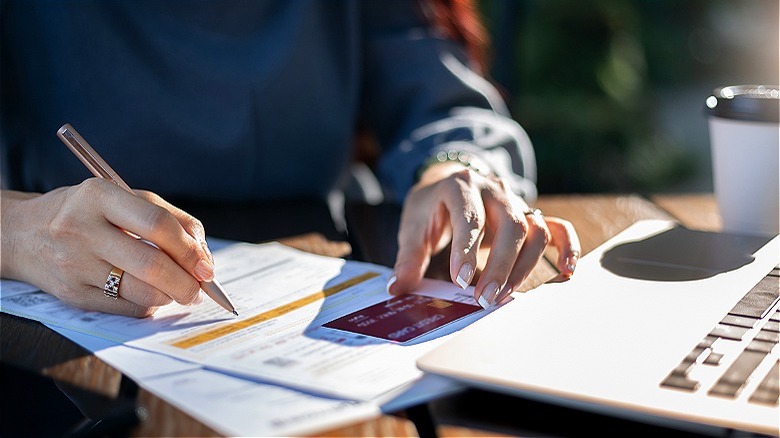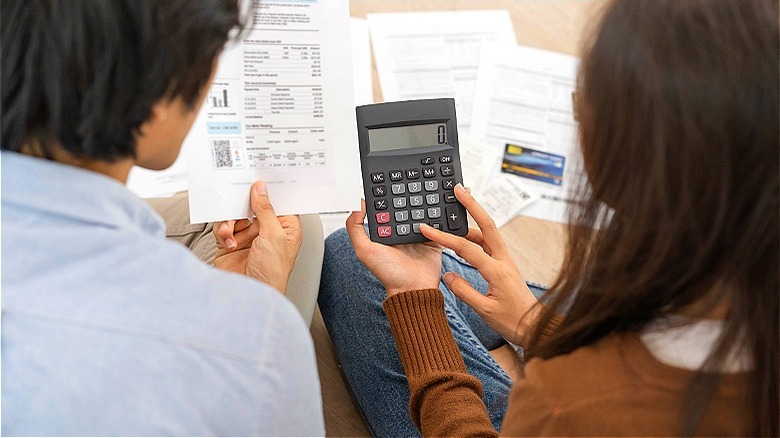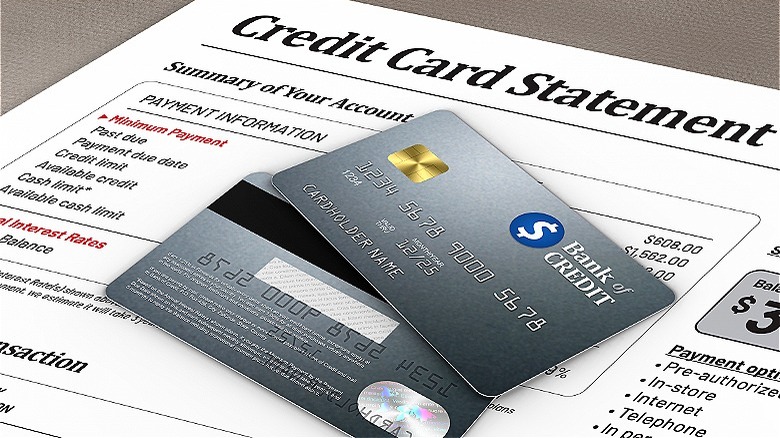5 Things To Do Before You Dispute A Credit Card Charge
Finding an unknown charge on your credit card statement can be distressing. After all, there are probably more than enough purchases you're sure are yours on the statement without also having to deal with the surprise of finding unexpected items driving up the total even higher. When you see something listed on your credit card statement you don't recognize, your first instinct might be to reach out to your credit card company to dispute the charge. However, that's not usually the best action to take — at least not right away.
The fact that you don't immediately recognize a charge doesn't mean it's an error, or act of fraud. With that in mind, there are a few things you should do before reporting an unrecognized charge on your statement — and that is to verify if it is, in fact, something that shouldn't be there. Not sure about the steps to take? No problem. Just work your way through the five that follow.
1. Search for the merchant's name online
If you see the name of a company you don't recognize on your credit card statement, it's natural to assume the charge is an error. However, some companies operate under multiple names, which can affect how they appear on a customer's credit card statement. For example, some organizations use one or more doing business as (DBA) names rather than their official corporate name on customer- facing communication, while others could be subsidiaries of organizations that maintain financial accounts — including their merchant account — under the name of the parent company.
As a result, when you come across an unrecognized name on a credit card bill, the first thing you should do is search the merchant's name online. A quick, online search can help you identify other business names associated with the merchant. You just may recognize one of the names that comes up and realize you did make a purchase there and that explains the charge on your account. It may even be possible you signed up for a free trial and didn't remember to cancel before the end of the trial period.
2. Check with other authorized users
After looking up the merchant name, even if you're sure you didn't make the initially unrecognized charge, there's a chance the charge is legit if anyone else is an authorized user on your account. With that in mind, if anyone else is authorized to use your card, check with them first before filing a credit card dispute. There's always a chance they bought something from the merchant and didn't think to tell you about it.
This is true even if your credit card company shows separate sections for each authorized user on your statement, as there's always a chance that another member of your household — or anyone else you've authorized to use your account — made a purchase from an online account where your card number is stored as a saved method of payment. They could've even borrowed your card to make a purchase because they couldn't find theirs, or yours was more convenient when they needed to pay for something over the phone or online.
3. Look for other charges by the merchant
If you're still unsure if the suspicious charge is correct or not, take some time to look through some past statements to see if any previous charges with this merchant show up, too. If you stumble across other charges from this merchant, this could jog your memory in regards to doing business with the company in the past. It could help you remember a recent purchase, for example, or identify a billing error, like a service you thought you canceled. A charge like this could be for a subscription or other type of recurring charge you (or authorized user) may have signed up for but haven't thought about for a while.
It's a good idea to glance back through a full 12 months of statements, as some subscriptions renew annually. This might sound time-consuming, but it doesn't have to be. Searching your statements for the past year is as easy as pulling up each statement via your online credit card account and using the find feature on your keyboard (Ctrl+F on a PC or command+F on a Mac) to look for the merchant name.
4. Identify if the charge is a billing error or fraud
Once you've gone through the steps above, you should have an idea of whether the charge should really be on your credit card account or not. If your sleuthing helped you figure out that the charge is legit, then you saved yourself and a merchant the hassle of having to deal with a disputed charge. However, if the charge remains unexplained, you'll still need to deal with the issue. At this point, you'll need to make a determination of whether you think the charge is an example of credit card fraud or simply a billing mistake.
If you canceled a subscription service, for example, but were still charged for it, that would be a billing error. However, if the charge is with an unfamiliar vendor or is a purchase that you or an authorized user couldn't possibly have made, then there's a good chance you're dealing with fraud. For instance, if you haven't traveled in years but there are Uber charges being made in Germany on your account, that's a sure sign someone is using your account fraudulently. In such a case, you should contact your credit card company immediately and report it.
5. Contact the merchant about the charge
Billing errors are mistakes that need to be corrected, but it's best to attempt to handle them directly with the merchant before filing a dispute with the credit card issuer. To do so, contact the merchant and explain the situation, then ask the charge be reversed. Assuming the mistake is obvious and the merchant recognizes it, they can simply process a chargeback. This will likely be easier — and faster — than if you attempt to dispute a charge with a credit card company without first approaching the merchant. A merchant can process a chargeback with a simple transaction, but it can take a credit card company up to 90 days to investigate and resolve this type of issue.
Ultimately, if the merchant isn't willing to work with you, the next step will be to file a dispute. In that case, be sure to provide documentation (like screenshots) of your attempts to get the merchant to correct the mistake. This information can help legitimacy to your dispute and potentially lead to a faster resolution.





